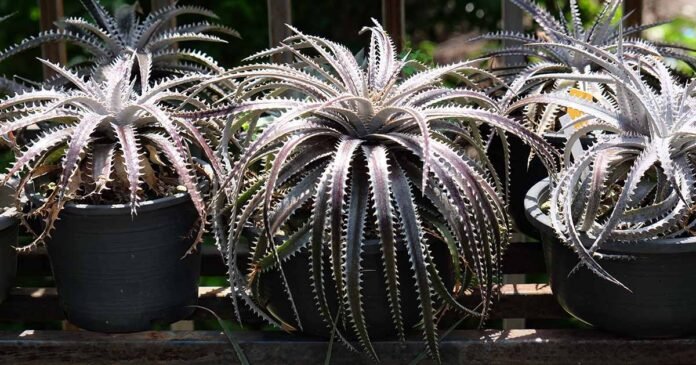Fertilizing
There’s no need to fertilize in-ground plants unless they are growing slowly then you can feed once in spring and once in late summer with a cactus and succulent fertilizer.
Container-grown specimens benefit from an application of fertilizer in spring and late summer.
Species and Cultivars
I can’t even begin to cover all of the incredible hybrids, cultivars, and species that are available.
I highly recommend heading to your local nursery and see if they have any. If they do, it will likely include the first plant on our list:
Arizona
One of the most popular hybrids is the 18-inch-wide ‘Arizona,’ with its dark blue-green leaves dotted with white spikes on the margins.

It’s often the one that stores will carry, and is the parent of so many other fantastic hybrids, including ‘Feather Star’ and ‘White Fang.’
‘Arizona’ was bred by Bill Baker, who was an avid plant hunter and nurseryman. He created numerous hybrids, some of which are the most popular and respected out there.
Dawsonii
The bronze leaves of D. dawsonii are lined with hooked spines on plants that can grow up to a foot wide, producing yellow-orange flowers.


With a little extra sun, the leaves can even turn dark purple. The species is fairly rare in cultivation, but there are several cultivars and hybrids.
‘Brittle Star’ is a Bill Baker hybrid that’s wildly popular and takes after its dawsonii parent with dark purple, nearly black leaves. It also has D. fosteriana and D. platyphylla parentage.
Delicata
My heartfelt thanks goes out to the botanists who found D. delicata species in the high altitudes of southern Brazil in 1996. This is such a cool species.


The foliage forms a compact rosette, with leaves that curl downward into a spiky little orb. The tips of the leaves can even dig into the soil or hang below the rim of a container.
Foliage can be green, red, or gray, all covered in silver flocking. There’s also a striking gold form with yellow-gold foliage.
The long, pointed spines might look intimidating, but they’re surprisingly soft to the touch. Go ahead, this is one dyckia you can safely pet.
Fosteriana
This species has narrow, silvery-white leaves accented by heaps and heaps of spines along the edges. The leaves are exceptionally curvy and can drape below the rim if you grow it in a pot.


The plants stay small, growing to just about eight inches tall and a bit wider when mature. Another check in the “good for container cultivation” column.
They’re quick to mature and send out offsets, so you’ll be enjoying clusters of these plants in no time.
Look for varieties like nivosa, which matures at just about five inches across, or the rubra form, which turns a deep burgundy in bright light.
Goehringii
If you like your plants to be vicious, this species is for you. The margins of the leaves are lined with spines, and those spines are hooked at the ends.


Want to keep kids, pets, or pests out of the garden? Like the look of what one bromeliad forum user called “a bouquet full of razor wire?” Goehringii it is.
This species is also a good option if you want to propagate the pups.
They emerge on short stolons that hold the offsets away from the base of the mother plant, rather than clustered tightly around it.
Pineapple
Pineapple dyckia (D. brevifolia) certainly bears a resemblance to the plant from which it derives its common name. It has the same type of green, strappy leaves that give it a familiar look.


One notable hybrid is ‘Naked Lady,’ a cross between D. brevifolia and D. encholirioides. It features pale green to yellow foliage and grows up to a foot tall and even wider.
Since it lacks spines, this one is a good option for growing as a houseplant or for placing in high-traffic areas.
White
The botanical name D. marnier-lapostollei may be a mouthful, but the plant itself is undeniably stunning.
It has small, claw-like spines along the margins of gray-green leaves that appear nearly white thanks to a heavy coating of trichomes.


The leaves are deeply curved, often curling back beneath themselves or dipping below the rim of a container. They’re lined with spines that are relatively soft.
At maturity, the plant reaches about a foot tall and wide and produces flower spikes up to two feet tall topped with orange blooms. It grows well even in partial shade.
The species was named after Julien Marnier-Lapostolle of Grand Marnier liqueur fame, as the plant was discovered growing on one of his estates.
Wide Leaf
Known as wide-leaf dyckia, D. platyphylla has broader leaves than many other species, though each still tapers to a point.


The foliage is covered in stubby but sharp spines and dotted with silvery scales. In bright sun, the leaves can take on a bronze, red, or purple hue.
At maturity, plants reach about a foot tall and up to two feet wide, sending up tall stalks of yellow flowers.
To be perfectly accurate, it’s not entirely clear whether this plant is a true species or a hybrid. It was first described in 1970 by botanist and bromeliad expert Lyman Bradford Smith, based on a specimen collected by Bateman Foster.
But it has never been rediscovered in the wild, and some experts suspect it may be a hybrid.
The hybrid ‘Cherry Coke’ inherits its glossy leaves from D. platyphylla, while D. fosteriana contributes its tendency to shift color in the sun.


